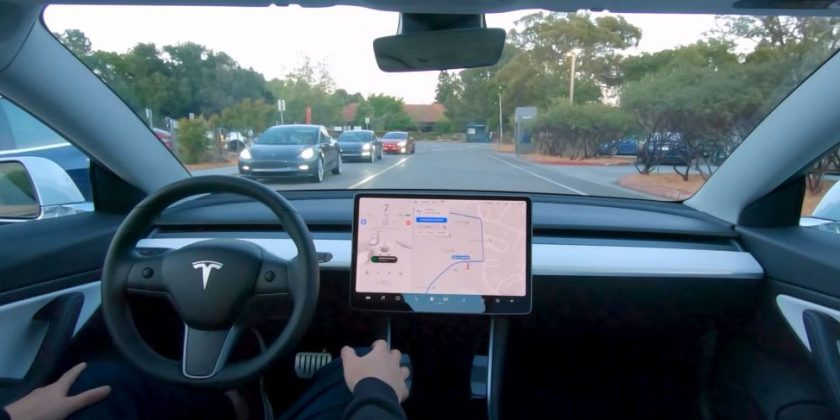After an evening tweet on October 20 promising “FSD beta rollout happening tonight,” Tesla CEO Elon Musk appears to have followed through. The automaker’s long-promised “Full Self-Driving” feature, which is allegedly a fully autonomous system, is entering “beta” testing—apparently with a select group of real-world Tesla owners.
The testing arrangement is, to put it mildly, unusual. Other companies working on self-driving cars are by and large using paid, trained staff or even engineers to man their vehicles while testing on real-world streets, people who can monitor the proceedings and intervene to avert accidents. (Famously, one such Uber monitor/driver was involved in such an accident; the tragic results made national news and Uber shut down its autonomous testing in Arizona as a result.) So, while the testing rollout “Will be extremely slow & cautious, as it should,” and “be limited to a small number of people who are expert & careful drivers” per Musk (in another tweet), we remain skeptical about the implementation.
Mostly that is because the full scope of the Full Self-Driving beta version (FSD beta, for the hip crowd) is unclear. We’ve inquired with the company, but Tesla recently did away with its public relations team, making it difficult to get answers to even basic inquiries. That means, other than Elon’s tweets, there is no public statement on the extent of the FSD beta’s capabilities, or on what if any restrictions, guidelines, or safety protocols have been given to the beta testers about how to monitor the system as it’s working. Perhaps the FSD beta setup is only a mild extension of today’s Autopilot adaptive cruise control and lane-keep system, which recently rolled out stoplight detection for expanded use on surface streets; or maybe the beta tests are for something closer to fully autonomous driving. We just don’t have that information.
Instead, we have a series of YouTube clips and social-media videos of those beta testers crowing about how cool it is that their Tesla can execute street-level moves such as a right-hand turn from one surface street to another, while traveling through a traffic light. Tesla seems to enjoy this kind of PR stunting (even if it lacks a formal PR department now), where real-world fans disseminate splashy news without any pesky reality checks. The rollout of Autopilot, the brand’s existing driver-assistance system, was peppered with self-created media from drivers engaging in all manner of silly stunts (such as leaving the driver’s seat while the car was in motion) to show how apparently capable the system was. This led to many laypeople believing Teslas can “drive themselves” even now, before FSD was introduced. Autopilot is one of the most capable driver assists out there, but it is not an autonomous system, despite its suggestive name and reputation.
What Is Full Self Driving?
It’s worth noting how big this step is for Tesla and its FSD system. Currently, Tesla cars and SUVs offer Autopilot, a feature that bundles adaptive cruise control and a self-steering lane-keep system to whisk occupants along without driver intervention for long stretches. Autopilot can also execute on-demand lane changes, taking in readings from the blind-spot monitoring system to ensure no vehicles are in the adjacent lane.
Full Self-Driving software works with additional hardware—sensors and the like—that all Teslas have had installed for some time to support automated driving functionality. Tesla buyers can purchase FSD today for $8,000, with the promise that when FSD is rolled out via software update, they’ll have the feature for less than Tesla might charge new customers in the future. To that end, Mr. Musk even tweeted the following, promising a forthcoming price increase for FSD:
Here is what Full Self-Driving entails, in Tesla’s words, which insists it will be available by the end of 2020 (after saying the same thing about 2019):
- Navigate on Autopilot (Beta): Actively guides your car from a highway’s on-ramp to off-ramp, including suggesting lane changes, navigating interchanges, automatically engaging the turn signal and taking the correct exit
- Auto Lane Change: Assists in moving to an adjacent lane on the highway when Autosteer is engaged
- Autopark: Helps automatically parallel or perpendicular park your car, with a single touch
- Summon: Moves your car in and out of a tight space using the mobile app or key
- Smart Summon: Your car will navigate more complex environments and parking spaces, maneuvering around objects as necessary to come find you in a parking lot.
- Traffic and Stop Sign Control (Beta): Identifies stop signs and traffic lights and automatically slows your car to a stop on approach, with your active supervision
- Upcoming:
- Autosteer on city streets
From the videos of FSD beta circulating online, it appears as though “Autosteer on city streets” is in full swing; we’ve also seen Smart Summon and Traffic and Stop Sign Control in action, along with early forms of Auto Lane Change. While it seems as though Tesla has most of the boxes checked for Full Self-Driving capability, we should remind everyone that even Tesla’s website notes the road ahead will be filled with much more testing, more hurdles, and—yes—continued driver engagement and attentiveness:
“The currently enabled features require active driver supervision and do not make the vehicle autonomous. The activation and use of these features are dependent on achieving reliability far in excess of human drivers as demonstrated by billions of miles of experience, as well as regulatory approval, which may take longer in some jurisdictions. As these self-driving features evolve, your car will be continuously upgraded through over-the-air software updates.”
Source: Read Full Article
